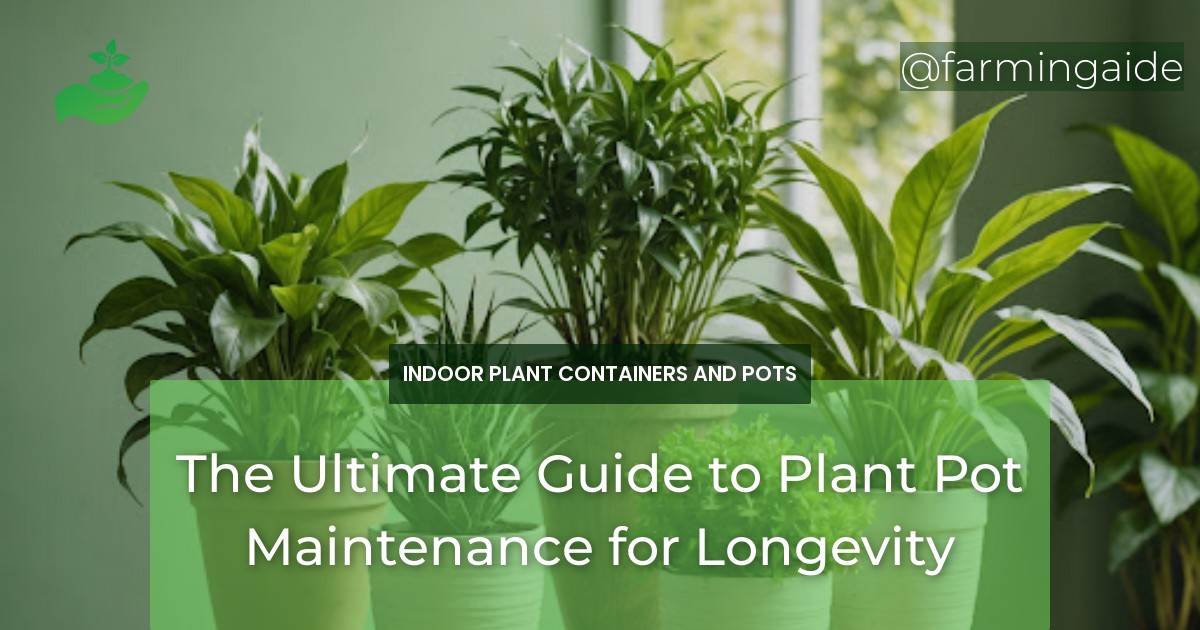Welcome to our comprehensive guide to plant pot maintenance for longevity! As a plant enthusiast, you understand the importance of providing your plants with a healthy and thriving environment. One crucial aspect of plant care is often overlooked: plant pot maintenance. In this article, we’ll delve into the importance of regular maintenance, types of plant pots and their specific needs, essential practices to prolong the life of your pots, and expert tips for ensuring your plant pots remain in top condition.
Key Takeaways
- Regular maintenance is crucial for plant pot longevity
- Different types of plant pots have specific maintenance needs
- Proper drainage, cleaning, and repair are essential for pot longevity
- Seasonal care and protection from extreme weather are vital
- Choosing the right pot size and material is crucial for plant health
Importance of Plant Pot Maintenance
Plant pot maintenance is often neglected, leading to a shortened lifespan for your pots and potential harm to your plants. Neglecting pot maintenance can cause waterlogged soil, root rot, and pest infestations, ultimately affecting plant health. Regular maintenance ensures your pots remain in good condition, allowing your plants to thrive.
By understanding the importance of plant pot maintenance, you’ll be able to identify potential issues before they become major problems. This proactive approach will save you time and money in the long run, as you’ll avoid costly pot replacements and plant losses.
Benefits of Regular Maintenance
Regular maintenance offers numerous benefits, including:
- Prevents waterlogging and root rot
- Reduces pest infestations and fungal diseases
- Enhances plant growth and health
- Prolongs the life of your plant pots
- Saves time and money in the long run
Common Issues with Neglected Pots
Neglecting plant pot maintenance can lead to a range of issues, including:
- Waterlogged soil and root rot
- Pest infestations and fungal diseases
- Cracked or broken pots
- Soil erosion and nutrient depletion
- Reduced plant growth and health
Types of Plant Pots and Their Maintenance Needs
Different types of plant pots have unique maintenance needs. Understanding these needs will help you provide the best possible care for your pots and plants.
ALSO READ
Ceramic Pots
Ceramic pots are popular for their aesthetic appeal and durability. To maintain ceramic pots:
- Avoid using abrasive cleaners or scrubbers
- Wipe down pots with a soft cloth to remove dirt and debris
- Apply a ceramic sealant to protect the glaze
Plastic Pots
Plastic pots are lightweight and inexpensive. To maintain plastic pots:
- Wash with mild soap and water
- Avoid exposing to extreme temperatures
- Drill drainage holes in the bottom for optimal drainage
ALSO READ
Wooden Pots
Wooden pots add a rustic touch to any garden or indoor space. To maintain wooden pots:
- Apply a waterproof sealant to protect the wood
- Avoid exposing to extreme temperatures or moisture
- Wipe down with a soft cloth to remove dirt and debris
Metal Pots
Metal pots are durable and modern. To maintain metal pots:
- Wash with mild soap and water
- Avoid exposing to extreme temperatures
- Apply a rust-resistant coating to protect the metal
Essential Maintenance Practices
Regular maintenance practices are crucial for prolonging the life of your plant pots. These essential practices include:
Cleaning and Sanitizing Pots
Cleaning and sanitizing your pots regularly will prevent the buildup of dirt, debris, and pests. Use mild soap and water, and avoid using abrasive cleaners or scrubbers.
Sanitize your pots by mixing one part white vinegar with nine parts water. Soak the pot in the solution for 10-15 minutes before rinsing thoroughly.
Repairing Cracks and Damage
Regularly inspect your pots for cracks or damage. If you notice any issues, repair them promptly to prevent waterlogging and pest infestations.
For ceramic pots, use a ceramic repair kit to fill cracks. For plastic pots, use a plastic adhesive to bond cracks. For wooden pots, use wood glue to repair cracks. For metal pots, use a metal adhesive to bond cracks.
Seasonal Care for Pots
Seasonal care is crucial for plant pot longevity. In the spring, inspect your pots for damage and clean them thoroughly. In the summer, ensure proper drainage and watering. In the fall, protect your pots from extreme weather. In the winter, bring pots indoors or use a frost blanket to protect them from frost.
Prolonging the Life of Your Plant Pots
By following these essential practices, you’ll be able to prolong the life of your plant pots and ensure your plants thrive.
Proper Drainage Techniques
Proper drainage is crucial for preventing waterlogging and root rot. Ensure your pots have adequate drainage holes, and use a well-draining potting mix.
| Pot Material | Drainage Holes |
|---|---|
| Ceramic | At least 1-2 holes (1/4 inch in diameter) |
| Plastic | At least 2-3 holes (1/4 inch in diameter) |
| Wooden | At least 2-3 holes (1/4 inch in diameter) |
| Metal | At least 2-3 holes (1/4 inch in diameter) |
Protecting Pots from Extreme Weather
Extreme weather can cause damage to your pots. Protect your pots by:
- Bringing them indoors during harsh weather
- Using a frost blanket to protect from frost
- Placing pots in a sheltered area
Choosing the Right Pot Size
Choosing the right pot size is crucial for plant health. Ensure the pot is large enough for the plant’s root system and has adequate drainage.
Conclusion and Final Tips for Plant Pot Longevity
By following these essential practices and tips, you’ll be able to prolong the life of your plant pots and ensure your plants thrive. Remember to:
- Regularly inspect and maintain your pots
- Choose the right pot material and size for your plant
- Provide proper drainage and watering
- Protect your pots from extreme weather
By implementing these practices, you’ll be able to enjoy a thriving garden or indoor space, while also ensuring the longevity of your plant pots.


